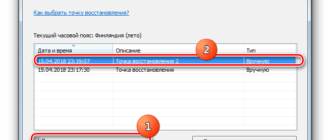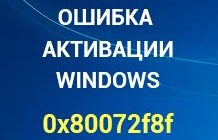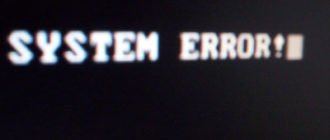In computer programming, error codes are enumerated messages that correspond to faults in a specific software application. They are typically used to identify faulty hardware, software, or incorrect user input in programming languages that lack exception handling, although they are sometimes also used in conjunction with exception handling. «Error codes» are not to be confused with return codes, although both are commonly used together in error handling.
Error codes and exception handling
Error codes are slowly disappearing from the programmer’s environment as modern object-oriented programming languages replace them with exceptions. Exceptions have the advantage of being handled with explicit blocks of code, separate from the rest of the code. While it is considered poor practice in methodologies that use error codes and return codes to indicate failure, programmers often neglect to check return values for error conditions. That negligence can cause undesirable effects, as ignored error conditions often cause more severe problems later in the program. Exceptions are implemented in such a way as to separate the error handling code from the rest of the code. Separating the error handling code from the normal logic makes programs easier to write and understand, since one block of error handling code can service errors from any number of function calls. Exception handling also makes the code more readable than implementations with error codes, since exception handling does not disrupt the flow of the code with frequent checks for error conditions.
HTTP 403
A web server may return a 403 Forbidden HTTP status code in response to a request from a client for a web page or resource to indicate that the server can be reached and understood the request, but refuses to take any further action. Status code 403 responses are the result of the web server being configured to deny access, for some reason, to the requested resource by the client.
A typical request that may receive a 403 Forbidden response is a GET for a web page, performed by a web browser to retrieve the page for display to a user in a browser window. The web server may return a 403 Forbidden status for other types of requests as well.
The Apache web server returns 403 Forbidden in response to requests for url paths that correspond to filesystem directories, when directory listings have been disabled in the server and there is no Directory Index directive to specify an existing file to be returned to the browser. Some administrators configure the Mod proxy extension to Apache to block such requests, and this will also return 403 Forbidden. Microsoft IIS responds in the same way when directory listings are denied in that server. In WebDAV, the 403 Forbidden response will be returned by the server if the client issued a PROPFIND request but did not also issue the required Depth header, or issued a Depth header of infinity.
DD-WRT
DD-WRT is a Linux-based firmware for wireless routers and wireless access points. It is compatible with several models of routers and access points, for example, the Linksys WRT54G series (including the WRT54GL and WRT54GS). DD-WRT is one of the third-party firmware projects, which are designed to replace the original firmware on some commercial routers. Alternative firmware may offer features and functionality sets that differ from the original firmware it is replacing.
The firmware project’s name, DD-WRT, was taken in part from the Linksys WRT54G model router, a successful home router popular in 2002–2004, for which the first replacement firmware was written. «DD» are the German license plate letters for all cars from Dresden, where the «Brainslayers» development team lived. «WRT», also used by the OpenWRT router firmware project, is coming to be a generic abbreviation for «Wireless RouTer», which may have been Linksys’s original meaning.
DD-WRT includes such features as support for the Kai network, daemon-based services, IPv6, Wireless Distribution System, RADIUS, advanced quality of service, radio output power control, overclocking capability, and software support for a Secure Digital card hardware modification.

Code (law)
A code is a type of legislation that purports to exhaustively cover a complete system of laws or a particular area of law as it existed at the time the code was enacted, by a process of codification. Though the process and motivations for codification are similar in different common law and civil law systems, their usage is different. In a civil law country, a Code typically exhaustively covers the complete system of law, such as civil law or criminal law. By contrast, in a common law country with legislative practices in the English tradition, a Code is a less common form of legislation, which differs from usual legislation that, when enacted, modify the existing common law only to the extent of its express or implicit provision, but otherwise leaves the common law intact. By contrast, a code entirely replaces the common law in a particular area, leaving the common law inoperative unless and until the code is repealed. In a third case of slightly different usage, in the United States and other common law countries that have adopted similar legislative practices, a Code is a standing body of statute law on a particular area, which is added to, subtracted from, or otherwise modified by individual legislative enactments.
Ten-code
Ten-codes, officially known as ten signals, are brevity codes used to represent common phrases in voice communication, particularly by law enforcement and in Citizens Band (CB) radio transmissions.
The codes, developed in 1937 and expanded in 1974 by the Association of Public-Safety Communications Officials-International (APCO), allow for brevity and standardization of message traffic. They have historically been widely used by law enforcement officers in North America but due to the lack of standardization, in 2006 the U. S. federal government recommended they be discontinued in favor of everyday language.
History
APCO first proposed Morse code brevity codes in the June, 1935 issue of The APCO Bulletin, which were adapted from the procedure symbols of the U. S. Navy.
The development of the APCO Ten Signals began in 1937, when police radio channels were limited to reduce use of speech on the radio. Credit for inventing the codes goes to Charles «Charlie» Hopper, communications director for the Illinois State Police, District 10 in Pesotum, Illinois. Hopper had been involved in radio for years and realized there was a need to abbreviate transmissions on State Police bands. Experienced radio operators knew the first syllable of a transmission was frequently not understood because of quirks in early electronics technology. Radios in the 1930s were based on vacuum tubes powered by a small motor-generator called a dynamotor. The dynamotor took from 1/10 to 1/4 of a second to «spin up» to full power. Police officers were trained to push the microphone button, then pause briefly before speaking; however, sometimes they would forget to wait. Preceding each code with «ten-» gave the radio transmitter time to reach full power. An APCO Bulletin of January 1940 lists codes assigned as part of standardization;
The Good Guys (2010 TV series)
The Good Guys is an American action-comedy series about an old-school cop and a modern-day detective that premiered with a preview episode on Fox on May 19, 2010, and began airing regularly on June 7 of that year. The series stars Bradley Whitford as Dan Stark, a mustachioed, former big-shot detective with the Dallas Police Department, and Colin Hanks as Jack Bailey, a young, ambitious, by-the-book detective who has been assigned as Dan’s partner because of his snarky attitude.
On December 15, 2010, The Good Guys was cancelled by Fox Television Studios.
List of HTTP status codes
The following is a list of Hypertext Transfer Protocol (HTTP) response status codes. This includes codes from IETF internet standards as well as other IETF RFCs, other specifications and some additional commonly used codes. The first digit of the status code specifies one of five classes of response; the bare minimum for an HTTP client is that it recognises these five classes. The phrases used are the standard examples, but any human-readable alternative can be provided. Unless otherwise stated, the status code is part of the HTTP/1.1 standard (RFC 7231).
The Internet Assigned Numbers Authority (IANA) maintains the official registry of HTTP status codes.
Microsoft IIS sometimes uses additional decimal sub-codes to provide more specific information, but these are not listed here.
1xx Informational
Request received, continuing process.
This class of status code indicates a provisional response, consisting only of the Status-Line and optional headers, and is terminated by an empty line. Since HTTP/1.0 did not define any 1xx status codes, servers must not send a 1xx response to an HTTP/1.0 client except under experimental conditions.
Исправить код ошибки 90403 в панели управления Wi-Fi роутера TP-Link
Если ты видишь Код ошибки 90403, Ошибка неизвестна сообщение при доступе к TP-Link Wi-Fi Панель управления маршрутизатором, тогда этот пост вам поможет. Вы можете столкнуться с этой проблемой в Панели управления при первой настройке или при внесении изменений в уже настроенный маршрутизатор.

Все сообщение об ошибке говорит примерно так:
Он также показывает Обновить кнопка, которая обычно ничего не делает. Тем не менее, всегда разумно сначала нажать на эту кнопку и посмотреть, есть ли небольшая внутренняя проблема.
Почему это появляется
Основная причина этой проблемы – недоступность подключения к Интернету от источника маршрутизатора во время его настройки. Предположим, вы впервые настраиваете роутер. Для этого вы подключаете свой компьютер к этой сети, входите в панель управления и вводите необходимые данные. Выполняя все эти действия, вы должны поддерживать соединение с вашим маршрутизатором. Эта ошибка возникает только при отключении от роутера при вводе данных.
Может быть несколько причин, по которым вы внезапно отключаетесь от маршрутизатора.
- Маршрутизатор больше не реагирует.
- Драйверы WiFi создают проблемы.
- Сетевой адаптер имеет конфликт.
Эта статья поможет вам выяснить источник этой проблемы и решить ее.
Код ошибки 90403 в панели управления WiFi-роутера TP-Link
Чтобы исправить код ошибки 90403 в панели управления Wi-Fi маршрутизатора TP-Link, выполните следующие действия:
- Проверьте исходное интернет-соединение
- Используйте другой компьютер
- Подключитесь к сети 2,4 ГГц
- Проверить ключ Wi-Fi
- Установите драйвер WiFi
- Запустите средства устранения неполадок сети
Давайте посмотрим на подробную версию этих решений, чтобы узнать больше.
1]Проверьте исходное интернет-соединение
Как упоминалось ранее, вы должны проверить скорость отклика WiFi-роутера. Независимо от того, новый у вас роутер или старый, в устройстве могут быть производственные дефекты, которые могут стать причиной всей проблемы.
Почти все маршрутизаторы Wi-Fi имеют светодиодный индикатор «Интернет», который горит, если они получают источник Интернета для трансляции вашего Wi-Fi-соединения. Проверьте, горит ли этот светодиод. Или перезапустите маршрутизатор, чтобы решить общие проблемы.
2]Используйте другой компьютер
Если первое решение не работает в вашу пользу, пора проверить ваш компьютер. Лучше всего использовать другой компьютер, чтобы сразу решать обычные проблемы. Иногда компонент Wi-Fi компьютера перестает работать из-за некоторых внутренних проблем. Вот почему вы можете выбрать другое устройство, чтобы убедиться, что проблема исходит от вашего компьютера.
3]Подключитесь к сети 2,4 ГГц

Если ваш маршрутизатор поддерживает диапазоны 5 ГГц и 2,4 ГГц, и вы подключены к сети 5 ГГц, лучше выбрать 2,4 ГГц. В 2,4 ГГц и 5 ГГц числа относятся к двум разным «диапазонам», которые ваш Wi-Fi может использовать для своего сигнала.
В общем случае это не имеет значения, поскольку обе сети работают одновременно. Однако, если ваше устройство не может вносить изменения в сеть 5 ГГц, переключитесь на 2,4 ГГц.
Бонусный совет: Не стесняйтесь переключаться с 2,4 ГГц на 5 ГГц, если вы получаете сообщение об ошибке на частоте более 2,4 ГГц.
4]Проверить ключ Wi-Fi
Если вы используете ноутбук с Windows 10 или Ethernet-соединение для настройки маршрутизатора, это решение не для вас. Однако, если вы используете сторонний ключ Wi-Fi для подключения компьютера к сети Wi-Fi, лучше проверить, работает ли ключ без проблем или нет.
Если ваш WiFi-ключ поставляется с компакт-диском с драйверами, удалите существующий драйвер и переустановите его. Даже если у вас нет компакт-диска с драйверами, посетите веб-сайт производителя, откуда вы можете загрузить драйвер и установить его в своей системе.
После этого попробуйте следующее:
- Вставьте ключ WiFi в другой порт USB. Вместо того, чтобы вставлять его в порт корпуса ЦП, лучше использовать порт USB на задней панели.
- Вставьте ключ WiFi в другой компьютер, чтобы проверить, работает он или нет.
5]Установите драйвер WiFi
Если вы используете ноутбук, который является встроенной функцией для обработки Wi-Fi-соединения, проверьте драйвер WiFi. Независимо от того, используете ли вы Windows 10, 8 или 7, каждой операционной системе требуется драйвер, чтобы все работало без сбоев. Поэтому убедитесь, что вы установили последнюю версию драйвера WiFi.
6]Запустите средства устранения неполадок сети

В Windows 10 есть встроенные средства устранения неполадок. Запустите следующие два средства устранения неполадок сети и посмотрите, поможет ли это:
- Сетевой адаптер
- Подключение к Интернету
Несмотря на то что Подключение к Интернету средство устранения неполадок может не показывать положительный результат, можно получить кое-что из Сетевой адаптер средство устранения неполадок.
Чтобы запустить их, откройте настройки Windows, нажав Win + I, и перейдите к Обновление и безопасность> Устранение неполадок. Теперь найдите эти средства устранения неполадок справа и запустите их один за другим. Вы также можете прочитать руководство по запуску средств устранения неполадок в Windows 10.
https://wn. com/Fix_Error_Code_18005_Of_Locked_Tp_Link_Tl_Wr841N_V9_To_Flash_Openwrt_And_Dd_Wrt_Firmware
https://zanz. ru/ispravit-kod-oshibki-90403-v-paneli-upravleniya-wi-fi-routera-tp-link/


